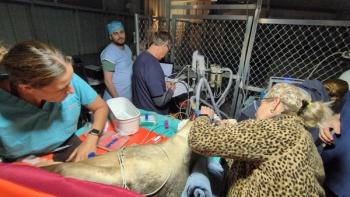
A trip through the eye (Proceedings)
An enhanced understanding of the anatomy of the eye will help you better evaluate the urgency of complaints regarding eye problems on the phone, facilitate history taking during appointments, and better convey proper treatment and monitoring to your patients owners.
An enhanced understanding of the anatomy of the eye will help you better evaluate the urgency of complaints regarding eye problems on the phone, facilitate history taking during appointments, and better convey proper treatment and monitoring to your patient's owners. We will break down the parts, roughly from front to back, so the eyes don't seem so “alien” anymore.
Eyelids
Function to protect and cover the eyes, assist in removing debris and spreading the tear film by blinking, can help limit light entering the eye, and provide the outer portion of the tear film (from the meibomian glands). The eyelashes are called cilia (when they exit the meibomian gland openings or the palpebral conjunctiva they are called distichia or ectopic cilia).
There is also a lacrimal gland contained beneath the upper eyelid that contributes most of the middle liquid layer of the tear film.
The third eyelid also provides protection to the eye and spreads the tear film and dislodges foreign material.
Conjunctiva
Is the elastic, light pink tissue that lines the eyelids and covers the globe. The goblet cells provide the inner layer of the tear film, and it also contributes to the immune system for the ocular surfaces. The palpebral conjunctiva lines the inner eyelids, the bulbar conjunctiva covers the globe, and there is also conjunctiva covering the front and back of the third eyelid.
The pre-corneal tear film coats the corneal surface and provides nutrition and oxygen to the outer cornea. It has antibiotic properties and flushes away debris and organisms. There are 3 layers to the tear film. The inner mucin layer is produced by the goblet cells of the conjunctiva, and adheres the tear film to the corneal epithelium. The middle aqueous layer is produced primarily by the lacrimal gland (2/3) and the gland of the third eyelid (1/3). The outer lipid layer exits the meibomian glands and prevents evaporation of the tear film. It is spread across the surface of the cornea by the eyelids, and then drains down the nasolacrimal ducts, which originate at the medial canthus and exit near the nostril.
Cornea
The clear windshield into the eye has 3 main layers you should recognize. There is an outer protective epithelial layer. Any injury to this will allow fluorescein stain to be retained within the cornea (corneal ulcer). The majority of the cornea is made of sheets of perfectly arranged, parallel sheets of collagen called the stroma. Corneal ulcers can be superficial with injury of just the epithelium, or deep, involving the stroma. The inner layers of the cornea are made of Descemet's membrane and the single layer endothelium which functions to pump fluid into the eye and keep the cornea dehydrated and clear. Ulcers that have reached all the way to this no longer retain fluorescein and are called descemetoceles (and are at imminent risk of rupture). The cornea is continuous (as the fibrous tunic) with the nontransparent sclera.
Anterior chamber
Fluid filled chamber between the cornea and the pupil/iris. Aqueous humor is consistently produced in the ciliary body (behind the iris) and flows from the posterior chamber into the anterior chamber, and then exits the eye at the iridocorneal angle (and, variable amounts depending on the species, the alternative uveoscleral pathway). This fluid provides nutrition and waste removal to structures like the lens and inner cornea. The balance in production and removal of this fluid maintains the intraocular pressure.
Uvea
Also known as the vascular tunic of the eye because it contains most of the blood vessels in the eye. Anteriorly, it begins as the iris which functions to dilate (mydriasis) or constrict (miosis) the pupil and adjust the amount of light entering the eye. The color of the eye is determined by the amount of pigment present in the iris.
As you move posteriorly in the eye, this tissue becomes the ciliary body, where the aqueous fluid is produced, and then the furthest posterior is the choroid. The choroid is a 4 layer structure that supports the retina and includes in some animals, including dogs and cats, the Tapetum lucidum (the reflective layer that creates the “eye shine”.
Lens
Layered like an onion, the lens sits just behind the iris and focuses light on the retina to provide clear vision. An aging change can be noted in middle aged dogs where increasing density gives the lens a gray appearance called nuclear sclerosis. Though most dogs continue to see without any noticeable problems they do lose some capacity to focus on close objects (just like when we start to need reading glasses).
A cataract is a white opacity in the lens fibers and does interfere with vision, to variable degrees depending on how much and where it is located. The lens is contained within a thin capsule connected to the ciliary processes by thin fibers called zonules. Loss of these zonules can lead to position changes (subluxation) or complete dislocation (luxation) of the lens within the eye.
Vitreous
Large, jelly-like structure behind the lens that supports the retina. It is 99% water and must remain clear for good vision. Aging changes, inflammation, retinal or lens disease, and glaucoma can cause opacification or liquification of the vitreous leading to visual impairments or increased risk of retinal detachment.
Retina
Thin, 10-layer, light sensitive tissue that lines the innermost part of the eye. Rods and cones take in light energy and turn it into impulses transmitted to the brain along the optic nerve and these interpreted as vision. You can think of it as the “film in the camera” of the eye. As this is actually an extension of the brain, this is the only place in the body where you can non-invasively see the central nervous system.
Dogs and cats do not see in black and white as is often thought, but they are dichromatic instead of trichromatic like us meaning they do not see color in the same spectrum (red/green color blind) with most objects appearing blue, yellow or some shade of gray. They have many more rods than cones (opposite of people) meaning their acuity is less than ours, but they see much better in lower lighting conditions and in perceiving movement.
Newsletter
From exam room tips to practice management insights, get trusted veterinary news delivered straight to your inbox—subscribe to dvm360.






